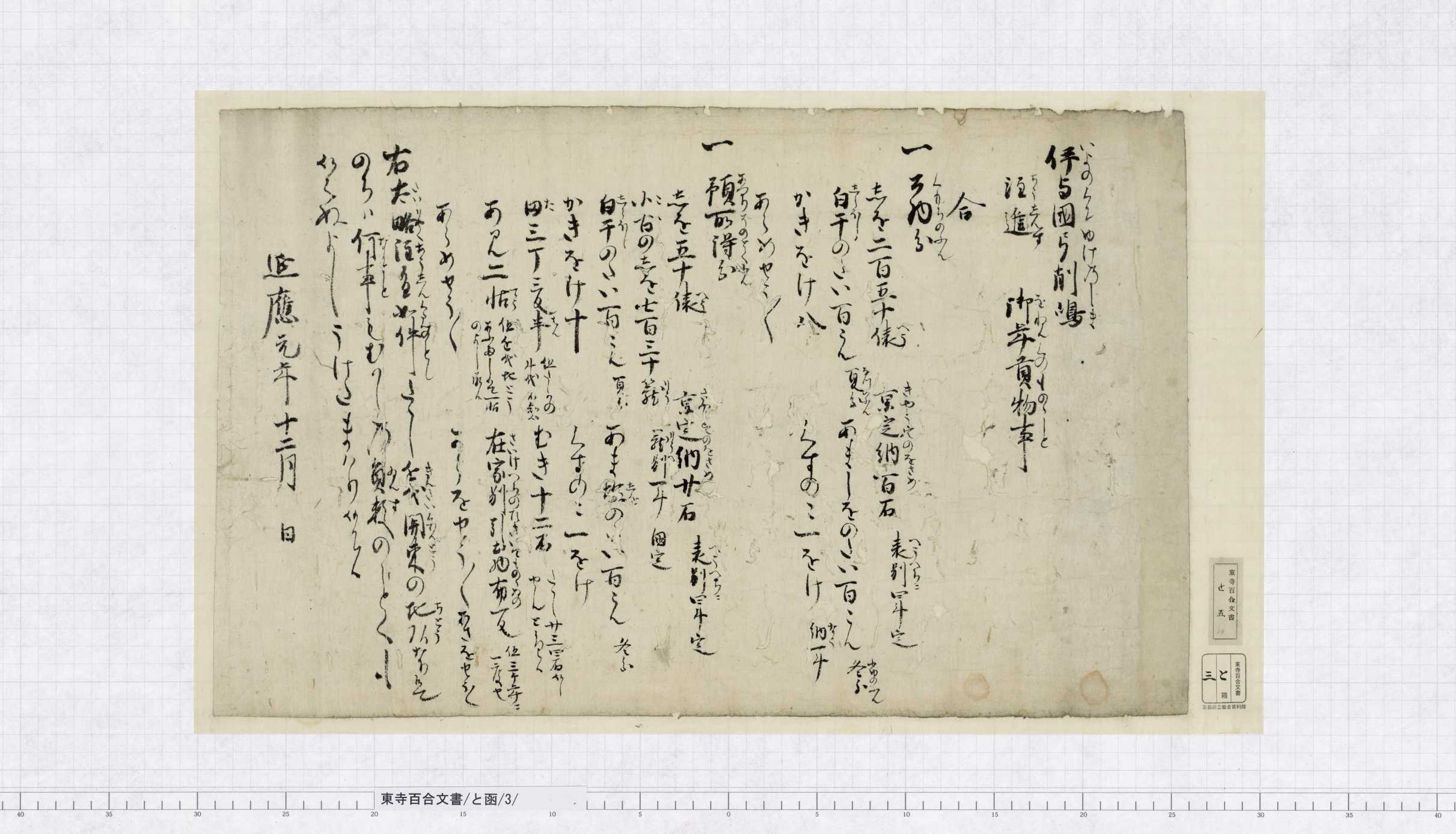Rice is the staple food for Japanese. Not a few Japanese people would say that they could get satisfied only with white rice, even if there were no other dishes. Rice has always been indispensable in Japan’s dietary life, though there was not as much rice as in the present day to be generously served to common people.
Rice was also delivered as the primary land tax. You may have seen drawings of many rice bags being transported in a textbook of history or elsewhere.
Today’s story is not about rice. Diverse kinds of land tax were delivered from Shoen (manors) located in different regions, just as suggested by a wide variety of specialty food products across Japan.
The Toji temple had Shoen in as many as 80 areas around Japan. Today’s story features a Shoen that delivered particularly unique land tax.

Yugeshima(弓削島), Iyonokuni (the present Ehime Prefecture), is a small island in the Seto Inland Sea. It is located immediately in the south of the Innoshima island(因島), near the present Shimanami Kaido route(しまなみ街道).
Yugeshima is a small island, and does not have many large farm fields. Instead, it is surrounded by the sea. What kinds of land tax were delivered to Toji from this island?
The document above indicates a list of items to be delivered as land tax. This list was submitted when Yugeshima was donated to Toji. It is a rare document with furigana (hiragana for showing how to read kanji) written beside the kanji characters. There are hardly other such documents remaining today. We can tell how people read kanji in those days.
In the fourth line, it says “一 公物分 (Kumochi-no Fun)”, indicating that items listed in this section would be delivered to Toji. A little later we can see “一 預所得分 (Atsukariso-no Tokufun)”, which lists the share of “Atsukariso/Azukaridokoro”, the local managers of the manor. The respective items were as follows:
◆ Kumochi-no Fun, which was allocated to Toji
○ Salt: 250 bags
○ White dried sea bream: 100 kon (for summer); Lightly salted sea bream: 100 kon (for winter)
* “kon” is a unit used for counting fish
○ Oysters: Eight pails
○ Kuzuko (arrowroot starch): One pail
○ Arame (a kind of algae): A little
◆ Atsukariso-no Tokufun, which was allocated to the local managers
○ Salt: 50 bags
○ Koko-no Shio (salt): 730 ryu
○ White dried sea bream: 100 kon (for summer); Lightly salted sea bream: 100 kon (for winter)
○ Oysters: Ten pails
○ Kuzuko (arrowroot starch): One pail
○ Rice field: 3 cho 3 and a half tan (i.e. Rice: 33 and a half goku)
○ Barley: 12 goku
○ Nets: Two jo
○ Cloths: One tan (for each Zaike, once every three years)
○ Arame (a kind of algae): A little
○ Imo Asa (a kind of hemp yarn): A little
○ Asa Imo (hemp yarn): A little
Both lists mostly consist of marine products! In particular, it seems that this Yugeshimanosho manor delivered salt in place of rice.
In this document, “Kumochi-no Fun” lists “しを(塩)二百五十俵 京定納百石 表別四斗定” in the first line. “表別四斗定” means that one bag of salt was counted as four To of rice. Because one goku equaled ten To, this line signifies that 250 bags of salt that was delivered to Toji as land tax was worth 100 goku of rice. People on this island paid land tax not by komedawara (rice bags) but by shiodawara (salt bags).
Kumochi-no Fun, or the share for Toji, included no rice or other grains. This suggests that Yugeshimanosho was positioned as a source of salt and marine products.
The share for Atsukariso included rice and barley, as well as daily necessities, such as nets, cloths, and yarns. The local managers sometimes stayed in Kyoto, and locally managed the manor at other times. They may have stayed on the island when this document was written, and had daily necessities delivered to them as well.
On the list of Atsukariso-no Tokufun is “Koko-no Shio: 730 ryu”. “Ryu” means baskets, and another unit for counting salt, just like bags. This list uses bags for counting plain salt, and baskets for Koko-no Shio.
In other documents pertaining to Yugeshimanosho as well, several kinds of salt appear, such as “Zeze-no Shio(膳所の塩)”, “Kusate-no Shio(草手の塩)”, “Koyumi-no Shio(小弓の塩)”, “Magusa-no Shio(秣の塩)”, and “Jinsai-no Shio(神祭の塩)”, in addition to plain salt. “Jinsai-no Shio” may have been used for religious services. Details about other kinds of salt are unknown. They may have been named based on the methods for salt production, or named after salt fields that no longer exist today. Still in the present day, special salt products that are branded “XX-no Shio” are on the market. It seems that a variety of salt already existed in the medieval Japan.
There were also two types of sea bream that were delivered, white dried (directly dried without salting) in summer and lightly salted (for preservation) in winter.
In this way, diverse specialty products were gathered to Toji from its Shoen across Japan. Salt, sea bream, oysters, algae, and so on are still famous specialty products from areas around the Seto Inland Sea. It seems that our ancestors were so much fond of nice food products, just like us!